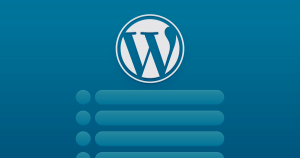WordPress on its own is a very popular and powerful Content Management System that allows the creation, management, and updating of content without any need for knowing or using code.
More than 40 percent of all websites use WordPress to some extent.
While WordPress is a great platform, sometimes more flexibility is needed to improve a website.
When this is the case, utilizing WordPress as a headless CMS can prove to work to your advantage.
Headless WordPress is something that is talked about relatively often, but it hasn’t yet become a mainstream thing.
Hearing the term makes you think it is only something to be spoken of and used by developers, but it has already made its way into the “real world” and found success.
If you are ready to learn more about headless WordPress and what it can potentially do for you, let’s dive on in. Here’s what you will learn below:
What is Headless WordPress?
Before we can delve into what a Headless WordPress is, let’s first define CMS.
CMS is short for Content Management System, which is the complete solution for the creation and management of online content like WordPress and website builders.
So, with that being said, where does the “headless” part come into play?
First of all, all websites, regardless of how they are formed, have a front end and a back end.
The front end is the way that visitors see your website. It is what you see right now as you are reading this blog.
The back end is where the management of the website occurs, such as creation and publishing of pages and blogs, customization of appearance and settings, adding new features with plug-ins, etc.
When the front end and back end are used together, this is known as a coupled CMS architecture.
This allows everything to be managed together within one program like WordPress, which is great for beginners.
When the architecture of the website is set up as “headless,” the front end of the platform is removed, leaving only the back end as well as the API.
Of course, you can still create, edit, upload, and organize content the way you would with a coupled system.
However, the difference is that you will access your resources via a separate front-end solution known as REST API.
This allows the now-headless CMS system to be used generically, regardless of what type of “language” is being used to develop the front end of the site.
So, you no longer have to be dependent on WordPress in order to display your content.
With that being said, it is important to note that the WYSIWYG editor is disabled, allowing you to utilize the REST API to manage your website functions.
The Benefits of Headless WordPress
A headless WordPress configuration offers numerous benefits, including more control and flexibility.
You will have full power over how and where the data and content are managed and stored in the back end, as well as full control over the visual display of your front-end content.
Here is a look at a few specific benefits of using headless WordPress.
Enhanced Security
While there are plenty of steps you can take to protect the traditional WordPress website, a headless setup tends to offer greater security.
When the front end of the system is separate with no reachable database and no active web server, it makes the site less likely to be attacked.
In other words, the headless WordPress configuration approach helps to prevent DDoS attacks, malicious requests, and unintentional exposure.
Better Flexibility
WordPress is an incredibly flexible program, with its customizable themes, plug-ins, etc.
However, some people may not want to control the front end of their website in this way. After all, it keeps you constrained by WordPress and particular elements.
By opting for a headless WordPress CMS, you are able to maintain the back-end content management part of WordPress that you are familiar with and love so much while outsourcing the front-end part to another software that allows greater flexibility in terms of coding and whatnot.
In doing this, you are not constrained by WordPress limitations, and you can alter the design of your site as much as you desire without having to worry about the content changing at all.
You can build your site from scratch if you want.
Quicker Performance
WordPress is a very well-optimized and oiled machine. But all that code ends up bogging your system down to a certain extent.
Plus, PHP is used to obtain resources from the database, assemble the page that the user has requested, and then send the requested page to the web user.
Unfortunately, this all takes time, and it can negatively impact the overall user experience, potentially reducing conversions.
Since user experience is imperative to your bottom line, it is crucial you figure out a way to minimize page load times.
While there are other ways to do this, decoupling the CMS is an effective way to improve your site’s performance.
When the front-end is separate from the back-end, your website will see a significant increase in load time. You can start assembling static HTML pages, which will be sent to web users immediately upon request.
Is Headless WordPress Always the Best Solution?
Absolutely not.
A headless WordPress setup is not the best solution for everyone.
However, there are certain instances when this configuration will work seamlessly for businesses, as there truly are advantages to the headless architecture.
Here are a couple of scenarios where a headless WordPress may indeed be the best solution.
#1: Static Microsites
If you have plans on building a microsite for a specific service or product, especially one that you expect will receive a significant amount of traffic, then a typical WordPress site may not be ideal.
A web server could crumble under all that pressure. However, a static website could make sense.
The pages will load faster (always good for the user experience) even if you don’t have a high-level web hosting package.
Since you want to ensure content management is easy and seamless for everyone, a headless WordPress configuration works perfectly.
You don’t have to train on a new system, since creating, editing, and uploading works the same as it always has.
#2: Mobile Application Content
When you need to send the content from your existing website to a mobile application, a headless WordPress can serve as a great solution.
It helps to maintain consistency across your brand while keeping you from having to start from scratch.
You can still have your full WordPress website with a front-end system and push that content to the mobile app with only a back-end system.
It’s ultimately a win-win situation for you and your customers.
How to Make WordPress Headless
If you decide that you want to move forward with a headless WordPress setup (which again means separating the back-end of WordPress from its front-end system), then you have a few different options available at your disposal to do so.
You can choose to code it yourself, or you can use a plug-in, with the latter, of course, being the easier route to take. Nevertheless, the former will offer more control over the entire process.
Regardless of your choice, it is a good idea to ensure you are familiar with REST API.
You can check out an online REST tutorial to help you familiarize yourself with it and get yourself started. You can learn even more from the tutorials provided by REST itself.
Using Plug-ins
If you are interested in using a plug-in, you should consider WP Headless, as this is the most popular plug-in used.
It will provide server access to the front end of the system and make it so that posting permalinks is an automatic redirect to the editor’s screen.
This can then be used as an organizational tool for any content already written. The API can be used to connect to a different site.
Another plug-in that can be used is the WP Headless CMS Framework.
It offers a more in-depth option with detailed documentation. It presents multiple configurable options, allowing you to enable or disable what you need or don’t need.
You have more flexibility with this plug-in when it comes to getting up and running with REST API.
DIY Coding
Now, if you choose to code it all yourself, you can find plenty of tutorials to help you, such as the in-depth headless WordPress guide from Smashing Magazine that offers step-by-step code snippets.
If you prefer to learn visually and follow along with someone as they “do,” then this Headless WordPress walkthrough is right up your alley.
The good news is that the online tutorials make it easier than ever to separate the front end and back end of WordPress so you can have a headless configuration moving forward, allowing you to post content across platforms with ease, code your site with familiar languages, and much more while still taking advantage of the familiarity of the back end of WordPress.
Examples of Headless WordPress
Although WordPress is still widely used traditionally, headless WordPress is becoming incredibly popular.
After all, it is being seen as the future of website design.
Here is a look at a few brands that are already using headless WordPress to power their sites.
#1: BeachBody on Demand
BeachBody on Demand is a streaming platform featuring workout videos, diet plans, and the like.
With a slick user interface of JavaScript, this fitness company’s website appears to be developed on none other than WordPress.
Because they chose to separate their front and back ends, they have been able to more efficiently push their content to their various platforms, which include the web, TV, mobile apps, and more.
Everything about this site is well-designed, allowing you to see that the headless WordPress configuration streamlines the management and automation of content and asset handling.
#2: TechCrunch
As one of the largest names in the tech news industry, TechCrunch redesigned its website back in 2018.
They wanted to create a design that was not only more accessible and user-friendly for their visitors, but they also wanted something that was better on their end.
Therefore, they opted to take advantage of technological advances and capitalize on the headless WordPress approach on top of a few other tech tools.
They now have a clean design that loads quickly for an improved user experience, and their site is easier to maintain behind the scenes.
#3: Facebook Brand Resource Center
The Facebook Brand Resource Center is a website that the ever-popular social media network utilizes as a style guide for its assets.
It is just another example of how headless WordPress is used brilliantly.
This particular website has a very unique and open design that adjusts well as you click through the different brands.
Once you reach one of the subpages, you will notice that the static elements of the page like the menu will remain visible on the screen at all times while other sections of the page load as you click around.
When you use the menus on the left side of the page, the scrolling effect is very smooth and seems effortless.
When compared to a standard PHP WordPress site, this one is very fluent and interactive.
Wrap Up: Are You Ready to Be a Part of the Future?
A headless WordPress CMS offers a little bit of something for everyone: editors, developers, and web users, including an easier and quicker content management process and a positive user experience with quick-loading pages.
Don’t forget that headless WordPress configuration is not right for every project. If it is the best approach for yours, then the benefits that you can reap from the switch are worth the effort.
Need web hosting for your WordPress site?
Speak to an expert about how Stage can improve your performance!










